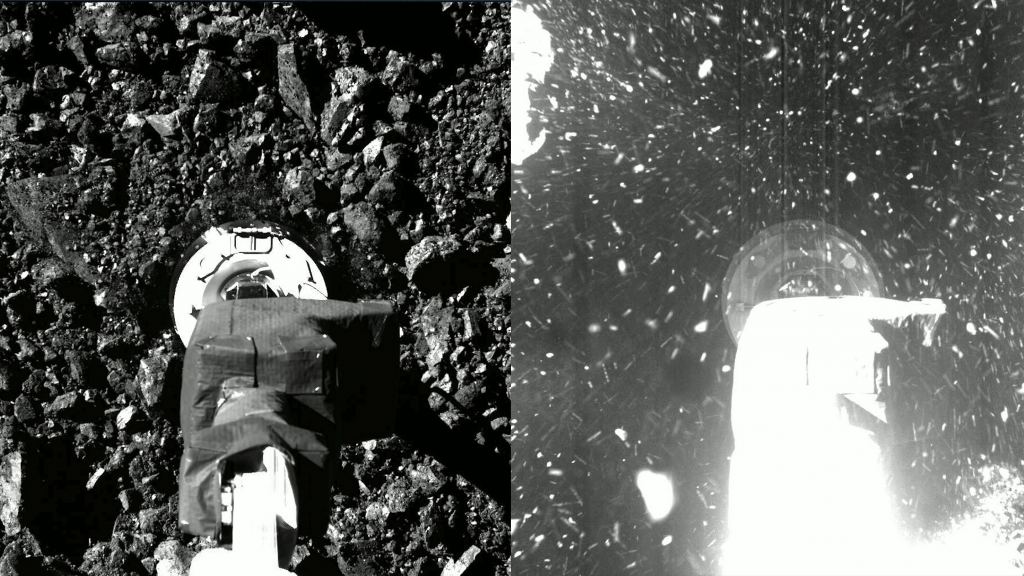A pair of studies published in Science and Science Advances have helped identify that NASA’s OSIRIS-REx (Origins, Spectral Interpretation, Resource Identification, Security-Regolith Explorer) spacecraft would have sunk into the asteroid Bennu had the spacecraft not fired its thrusters immediately after collecting samples from the surface of the small planetary body in October 2020. The respective studies examined the loosely packed exterior of Bennu, comparing its surface to stepping into a pit of plastic balls that people of all ages enjoy. The paper in Science was led by Dr.
David Lauretta, Principal Investigator of OSIRIS-REx and a Regents Professor at the University of Arizona, and the paper in Science Advances was led by Dr. David Walsh, a member of the OSIRIS-REx team from the Southwest Research Institute in Boulder, Colorado. This series of images shows the Touch-and-Go Sample Acquisition Mechanism (TAGSAM) instrument onboard NASA’s OSIRIS-REx spacecraft collecting its sample on asteroid Bennu in October 2020.
(Credit: NASA/Goddard/University of Arizona) “If Bennu was completely packed, that would imply nearly solid rock, but we found a lot of void space in the surface,” said Walsh. Launched on September 8, 2016, OSIRIS-REx is the first U. S.
mission to collect a sample from an asteroid. After conducting an Earth flyby a year later, OSIRIS-REx arrived at Bennu in December 2018 and successfully collected its sample in October 2020. The spacecraft then began its trip back home in May 2021 and its sample capsule is slated to return to Earth in September 2023.
Before OSIRIS-REx arrived at Bennu, the mission team observed the asteroid using Earth- and space-based telescopes expecting to find a surface that resembled a smooth, sandy beach. Instead, upon the spacecraft’s arrival at Bennu in December 2018, the team was surprised to find a surface littered with boulders and particle plumes erupting from Bennu’s surface. Mosaic image of asteroid Bennu is composed of 12 PolyCam images collected on Dec.
2, 2018, by the OSIRIS-REx spacecraft from a range of 24 km (15 miles). (Credit: NASA/Goddard/University of Arizona) When OSIRIS-REx ultimately collected its samples in October 2020 using its Touch-and-Go Sample Acquisition Mechanism (TAGSAM), the Sample Acquisition Verification Camera (SamCam) of the OSIRIS-REx Camera Suite (OCAMS) photographed stunning images of the sample site looking downward over TAGSAM every 1. 2 seconds with an image resolution of approximately 1 mm/pixel.
These frame-by-frame images from SamCam show substantial disturbances at the sample site caused by contact from TAGSAM. “What we saw was a huge wall of debris radiating out from the sample site,” Lauretta said. “We were like, ‘Holy cow!’” The mission team was even more startled when they saw the 8-meter (26-feet) wide crater that TAGSAM left despite how gently the spacecraft had touched the surface to collect the sample.
This result was in stark contrast to lab tests carried out before the mission. This series of images shows how Bennu’s surface was disturbed in three different ways: 1) the force of the spacecraft touching down; 2) the sampling mechanism, which collected material by blowing gas into its collection filter; and 3) the four spacecraft back-away thrusters, which moved the spacecraft away from the sample site (marked with a red “X” in the second of these two images), agitating dust and boulders on the surface. The image above shows the TAGSAM site and highlights (red circle) a large boulder thrown about 12 meters (about 40 feet).
(Credit: NASA/Goddard/University of Arizona) “Every time we tested the sample pickup procedure in the lab, we barely made a divot,” Lauretta said. A few months after sample collection, the team sent OSIRIS-REx back to take more images of Bennu’s surface “to see how big of a mess we made,” Lauretta said. By analyzing the volume of debris in sample site images before and after collection, along with studying acceleration data during spacecraft touch down, the mission scientists were able to deduce that Bennu experienced the same level of resistance that a person would feel while pressing the plunger (starting at 1:35 of the video) on a French press coffee carafe.
Imagine creating an 8-meter (26-feet) wide hole just by making coffee. These studies are intriguing since it challenges previous notions about the makeup of asteroids, which could aid in the design of future missions as well as developing methods to protect Earth form asteroid impacts. If asteroids are as loosely packed as Bennu, it’s possible they could simply break up in the Earth’s atmosphere, posing a different type of hazard than more solid asteroids.
Instead of a massive asteroid crashing into Earth, you might have hundreds of smaller pieces literally raining down from the sky and cause damage to a wider area. In the meantime, the OSIRIS-REx sample capsule is slated to arrive back on Earth in September 2023, and these samples might help us gain a better understanding of the makeup and composition of asteroids within our solar system. Is Bennu just one of many loosely packed asteroids roaming the solar system, or is it the exception? What will these samples teach us about asteroids and the history of the solar system? Only time will tell, and this is why we science! Sources: NASA, Science, Science Advances, NASA (2), NASA (3), YouTube As always, keep doing science & keep looking up! The post OSIRIS-REx Would Have Sunk Deep into Asteroid Bennu if it Tried to Land appeared first on Universe Today.
.
From: universetoday
URL: https://www.universetoday.com/156908/osiris-rex-would-have-sunk-deep-into-asteroid-bennu-if-it-tried-to-land/



